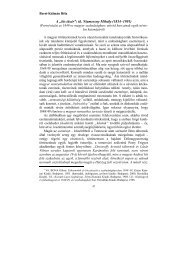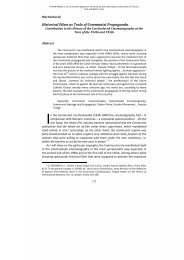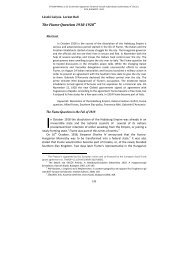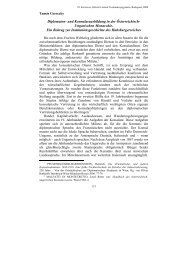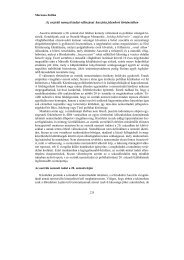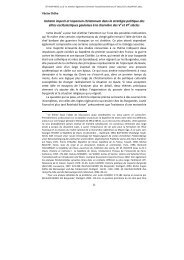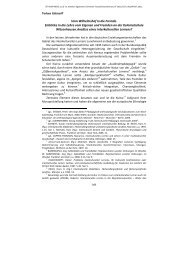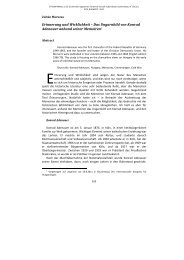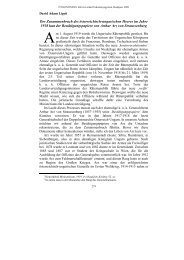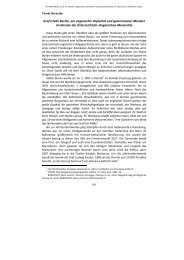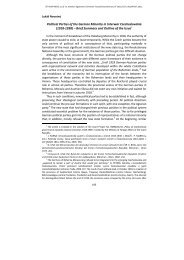The Molotov-Ribbentrop Pact - ELTE BTK Történelem Szakos Portál
The Molotov-Ribbentrop Pact - ELTE BTK Történelem Szakos Portál
The Molotov-Ribbentrop Pact - ELTE BTK Történelem Szakos Portál
Create successful ePaper yourself
Turn your PDF publications into a flip-book with our unique Google optimized e-Paper software.
Kałan, Dariusz<br />
<strong>The</strong> Ukrainian Question in German Foreign Policy<br />
(March 1938 - September 1939)<br />
Ukraine has played a great role in German political thought since at least<br />
18 th century. In the complex of common projects, the essential issue was the<br />
image of Ukraine as a path to Russia. Writers, politicians and historians, such<br />
as <strong>The</strong>odor Schiemann, Friedrich Naumann or Paul Rohrbach, the author of<br />
often-quoted maxim „who reigns in Kiev, reigns in Moscow” 1 , were convinced<br />
that the capture of Ukraine will become the grounds for economic and political<br />
crash of Russian Empire.<br />
However, the revival of folkish ideology in the early 1920s along with a<br />
new geopolitical conceptions designed by Friedrich Ratzel and popularized by<br />
Karl Haushofer allowed the role of Ukraine itself to be identified and valued.<br />
Haushofer, a professor of the University of Munich and creator of theoretical<br />
background of Adolf Hitler’s foreign policy, directed the German geopolitical<br />
expansion eastward. In his opinion there was a need to search for so-called<br />
„living space” (Lebensraum) for Germany due to its rise to greater prominence<br />
in Europe. Ukraine, abounded with fecund soils and numerous of raw<br />
materials, full of wild unspoiled landscapes, has been considered the perfect<br />
place for German colonization. Hence, during the 1930s Nazis didn’t lose sight<br />
of Ukraine as the crucial facet of all the variations of their eastern policy<br />
projects. <strong>The</strong> most audacious one, created by Richard Darré in 1932, assumed a<br />
German leadership role in the territories from Finland in the north through<br />
Poland, Ukraine, Hungary and Balkans to Georgia in the south 2 .<br />
Though Hitler did not mention Ukraine itself in an exposition of his political<br />
ideology in „Mein Kampf”, he clearly knew that Ukraine is crucial for<br />
Lebensraum to be successfully implemented. Hermann Rauschning, the author<br />
of „Hitler Speaks”, cited the Poland-related conversation with Führer from<br />
1934. Rauschning had suggested that Polish government would take back some<br />
selected western territories bordering with Germany, but in return should be<br />
given soils located at the Baltic Sea (Lithuania) and at the Black Sea (Ukraine).<br />
After Hitler carefully analyzed this proposal he finally declared: „<strong>The</strong>se<br />
gentlemen will have to Ukraine slip their mind” 3 . Obviously, this short<br />
statement is nothing like how Ukraine was described during the World War II.<br />
Four months after the Germany’s invasion of the Soviet Union Hitler wrote:<br />
„<strong>The</strong>re is no country that can be to larger extent autarkic than Europe will be.<br />
Where is there a region capable of supplying iron of the quality of Ukrainian<br />
1<br />
WILSON, Andrew. Ukraińcy. Translated by Marek Urbański. Warszawa, 1992. 306.<br />
2<br />
RAUSCHNING, Hermann: Rozmowy z Hitlerem. Translated by Ryszard Turczyn.<br />
Warszawa, 1994. 44.<br />
3<br />
Ibidem, 130.<br />
103



